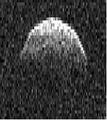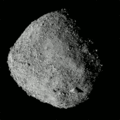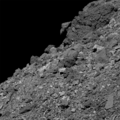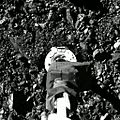101955 Bennu facts for kids
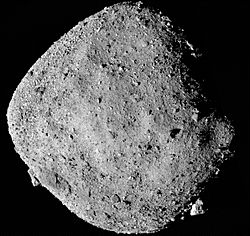
Mosaic image of Bennu consisting of 12 PolyCam images collected on 2 December 2018 by OSIRIS-REx from a range of 24 km (15 mi).
|
|||||||||||||||||
| Discovery | |||||||||||||||||
|---|---|---|---|---|---|---|---|---|---|---|---|---|---|---|---|---|---|
| Discovered by | LINEAR | ||||||||||||||||
| Discovery site | Lincoln Lab's ETS | ||||||||||||||||
| Discovery date | 11 September 1999 | ||||||||||||||||
| Designations | |||||||||||||||||
| MPC designation | (101955) Bennu | ||||||||||||||||
|
Named after
|
Bennu | ||||||||||||||||
| 1999 RQ36 | |||||||||||||||||
| Apollo · NEO · PHA · risk listed | |||||||||||||||||
| Orbital characteristics | |||||||||||||||||
| Epoch 1 January 2011 (JD 2455562.5 ) | |||||||||||||||||
| Uncertainty parameter 0 | |||||||||||||||||
| Observation arc | 21.06 yr (7693 days) | ||||||||||||||||
| Aphelion | 1.3559 au (202.84 Gm) | ||||||||||||||||
| Perihelion | 0.89689 au (134.173 Gm) | ||||||||||||||||
| 1.1264 au (168.51 Gm) | |||||||||||||||||
| Eccentricity | 0.20375 | ||||||||||||||||
| 1.1955 yr (436.65 d) | |||||||||||||||||
|
Average orbital speed
|
28.0 km/s (63,000 mph) | ||||||||||||||||
| 101.7039° | |||||||||||||||||
|
Mean motion
|
0° 49m 28.056s / day | ||||||||||||||||
| Inclination | 6.0349° | ||||||||||||||||
| 2.0609° | |||||||||||||||||
| 66.2231° | |||||||||||||||||
| Earth MOID | 0.0032228 au (482,120 km) | ||||||||||||||||
| Venus MOID | 0.194 au (29,000,000 km) | ||||||||||||||||
| Mars MOID | 0.168 au (25,100,000 km) | ||||||||||||||||
| Jupiter MOID | 3.877 au (580.0 Gm) | ||||||||||||||||
| TJupiter | 5.525 | ||||||||||||||||
| Proper orbital elements | |||||||||||||||||
|
Proper eccentricity
|
0.21145 | ||||||||||||||||
|
Proper inclination
|
5.0415° | ||||||||||||||||
|
Proper mean motion
|
301.1345 deg / yr | ||||||||||||||||
|
Proper orbital period
|
1.19548 yr (436.649 d) |
||||||||||||||||
| Physical characteristics | |||||||||||||||||
| Dimensions | 565 m × 535 m × 508 m | ||||||||||||||||
|
Mean radius
|
245.03±0.08 m | ||||||||||||||||
|
Equatorial radius
|
282.37±0.06 m | ||||||||||||||||
|
Polar radius
|
249.25±0.06 m | ||||||||||||||||
| 0.782±0.004 km2 | |||||||||||||||||
| Volume | 0.0615±0.0001 km3 | ||||||||||||||||
| Mass | (7.329±0.009)×1010 kg | ||||||||||||||||
|
Mean density
|
1.190±0.013 g/cm3 | ||||||||||||||||
|
Equatorial surface gravity
|
6.27 micro-g | ||||||||||||||||
| 4.296057±0.000002 h | |||||||||||||||||
| 177.6±0.11° | |||||||||||||||||
|
North pole right ascension
|
+85.65±0.12° | ||||||||||||||||
|
North pole declination
|
−60.17±0.09° | ||||||||||||||||
| 0.044±0.002 | |||||||||||||||||
|
|||||||||||||||||
| B F |
|||||||||||||||||
| 20.9 | |||||||||||||||||
101955 Bennu (provisional designation 1999 RQ36) is a carbonaceous asteroid in the Apollo group discovered by the LINEAR Project on 11 September 1999.
Bennu has a 1 in 2,700 chance of hitting Earth between the year 2178 and 2290, with the greatest risk being on 24 September 2182.
It is named after the Bennu, the ancient Egyptian mythological bird associated with the Sun, creation, and rebirth.
Bennu has an average diameter of 492 metres (1,614 feet).
Bennu is the second-highest on the cumulative rating on the Palermo technical impact hazard scale.
It is believed that Bennu broke off from another asteroid in the asteroid belt, but the gravitational pull of Saturn dislodged it into the range of Earth.
Bennu orbits the Sun every 1.2 years. It comes within 0.002 astronomical units of the earth every 6 years.
Some believe that if Bennu enters a specific hole between the earth and the moon its orbit could change in a way that would make it likely to hit Earth.
Bennu is the target of the OSIRIS-REx mission which is intended to return samples to Earth in 2023 for further study. In October 2020, OSIRIS-REx briefly landed on Bennu, collected a sample of the surface, and departed Bennu in May 2021. A capsule containing the samples landed on Earth in September 2023.
Possible Earth impact
On average, an asteroid with a diameter of 500 m (1,600 ft; 0.31 mi) can be expected to impact Earth about every 130,000 years or so. A 2010 study by Andrea Milani and collaborators predicted a series of eight potential Earth impacts by Bennu between 2169 and 2199. The authors recognized that an accurate assessment of 101955 Bennu's probability of Earth impact would require a detailed shape model and additional observations.
The publication of the shape model and of astrometry based on radar observations obtained in 1999, 2005, and 2011 made it possible to publish a revised assessment of the impact probability. If an impact were to occur, the expected kinetic energy associated with the collision would be 1,200 megatons in TNT equivalent (for comparison, TNT equivalent of Tsar Bomba, the most powerful nuclear weapon ever tested, was approximately 54 megatons).
Images for kids
-
Series of Goldstone radar images showing Bennu's rotation.
-
Animation of OSIRIS-REx's trajectory around 101955 Bennu from 25 December 2018 OSIRIS-REx · 101955 Bennu
-
Wide angle shot of the Northern Hemisphere of Bennu, imaged by OSIRIS-REx at an altitude of approximately 1.8 km (1.1 mi)
See also
 In Spanish: (101955) Bennu para niños
In Spanish: (101955) Bennu para niños


